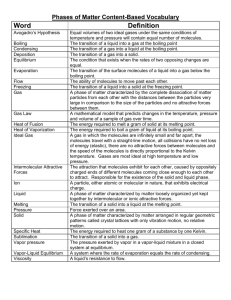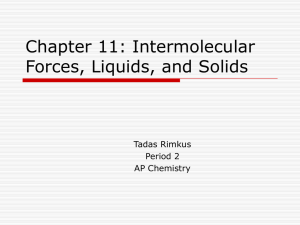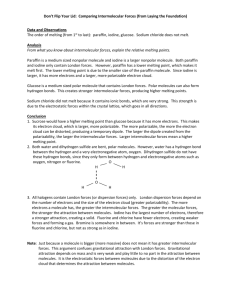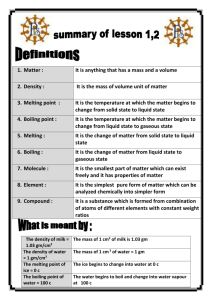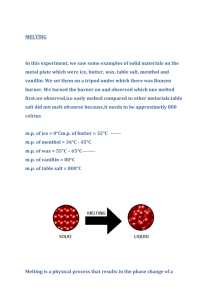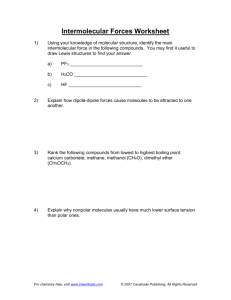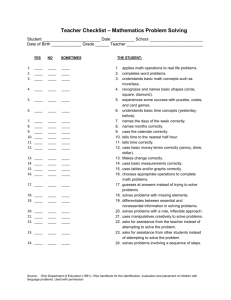128KB - NZQA
advertisement
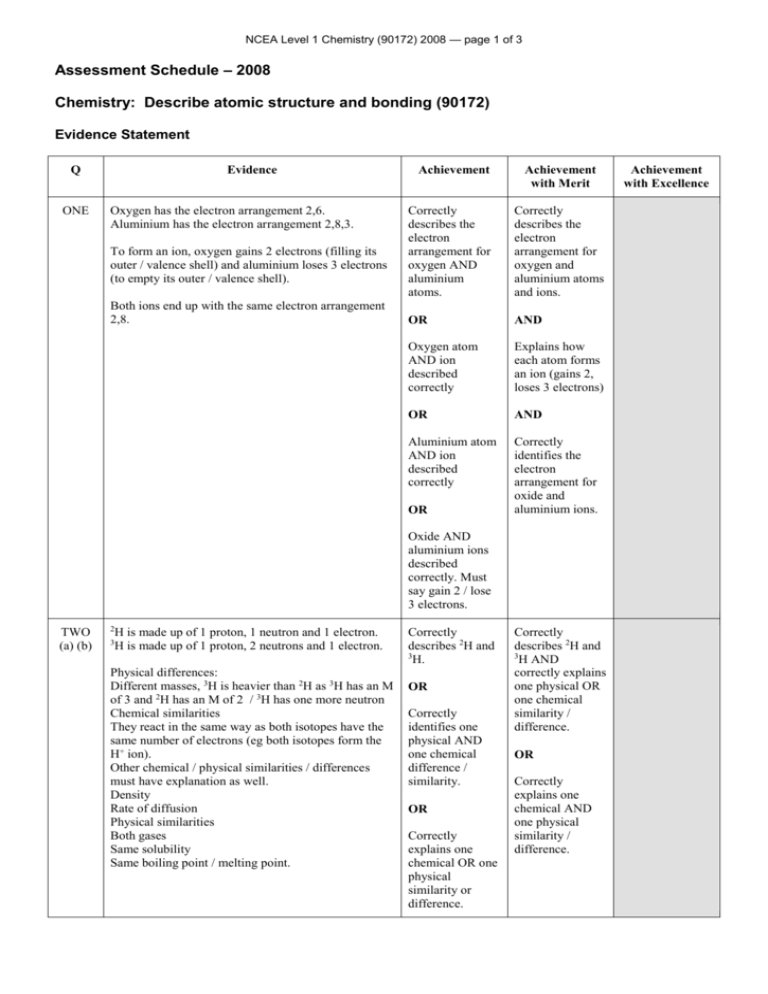
NCEA Level 1 Chemistry (90172) 2008 — page 1 of 3 Assessment Schedule – 2008 Chemistry: Describe atomic structure and bonding (90172) Evidence Statement Q ONE Evidence Oxygen has the electron arrangement 2,6. Aluminium has the electron arrangement 2,8,3. To form an ion, oxygen gains 2 electrons (filling its outer / valence shell) and aluminium loses 3 electrons (to empty its outer / valence shell). Both ions end up with the same electron arrangement 2,8. Achievement Achievement with Merit Correctly describes the electron arrangement for oxygen AND aluminium atoms. Correctly describes the electron arrangement for oxygen and aluminium atoms and ions. OR AND Oxygen atom AND ion described correctly Explains how each atom forms an ion (gains 2, loses 3 electrons) OR AND Aluminium atom AND ion described correctly Correctly identifies the electron arrangement for oxide and aluminium ions. OR Oxide AND aluminium ions described correctly. Must say gain 2 / lose 3 electrons. TWO (a) (b) 2 H is made up of 1 proton, 1 neutron and 1 electron. H is made up of 1 proton, 2 neutrons and 1 electron. 3 Physical differences: Different masses, 3H is heavier than 2H as 3H has an M of 3 and 2H has an M of 2 / 3H has one more neutron Chemical similarities They react in the same way as both isotopes have the same number of electrons (eg both isotopes form the H+ ion). Other chemical / physical similarities / differences must have explanation as well. Density Rate of diffusion Physical similarities Both gases Same solubility Same boiling point / melting point. Correctly describes 2H and 3 H. OR Correctly identifies one physical AND one chemical difference / similarity. OR Correctly explains one chemical OR one physical similarity or difference. Correctly describes 2H and 3 H AND correctly explains one physical OR one chemical similarity / difference. OR Correctly explains one chemical AND one physical similarity / difference. Achievement with Excellence NCEA Level 1 Chemistry (90172) 2008 — page 2 of 3 THREE H H C Any TWO correct. H F H H C F To gain Merit all diagrams must follow convention with electrons shown as either dots or crosses and clearly paired. Bonding electron pairs shown as dots or crosses should not be circled. H or Cl P Cl Cl P Cl Cl Cl or Cl O Cl Cl O Achievement plus COCl2 correct. Cl or Cl Cl O O C Cl FOUR (a) (b) C Cl Water is a molecule (made up of covalently bonded atoms). The attractive forces between the molecules are weak intermolecular forces Part A: Separation, close Energy, increasing Motion, can move past each other Attractive forces (as above) weak intermolecular. Part B: Separation, increasing distance between molecules Energy, breaking the intermolecular forces Motion, gas particles move faster Attractive forces, bonds broken. Here the liquid water changes to gaseous water. The molecules have the same amount of kinetic energy and motion, but separation is increasing. Correctly identifies water particles as molecules AND that there are weak intermolecular forces between the molecules OR Interprets graph correctly by describing 2 of the 4 points for Part A AND Part B. Correctly identifies water particles as molecules AND that there are intermolecular forces between the molecules AND Interprets graph correctly by EITHER Explaining what is happening in Part A OR Explaining what is happening in Part B (2 of the 4 points) OR Explaining 3 of 4 points for Part A and Part B. Correctly identifies water particles as molecules AND that there are intermolecular forces between the molecules AND Interprets graph correctly by explaining what is happening in Part A AND Explaining what is happening in Part B. The comparison between Part A and Part B must explain that while the temperature is constant, energy added in B is breaking the intermolecular bonds. NCEA Level 1 Chemistry (90172) 2008 — page 3 of 3 FIVE Sodium chloride is more likely to have the higher melting point. Sodium chloride is an ionic compound. (It is made up of metal and non-metal ions, so it will have ionic bonds.) Ammonia is a (covalent) molecule with weak intermolecular forces between the molecules. (It is made up of non-metal atoms, so it will have covalent bonds.) To melt sodium chloride, these very strong ionic bonds need to be broken. This requires a lot of energy, so sodium chloride will have a high melting point. To melt ammonia, the weak intermolecular forces need to be broken. This requires little energy, so ammonia will have a lower melting point than sodium chloride. Identifies NaCl as the compound with the higher melting point AND Describes NaCl as an ionic compound Identifies NaCl as the compound with the higher melting point AND Explains that NaCl is made up of ions Identifies NaCl as the compound with the higher melting point AND Explains that NaCl is made up of ions OR Identifies NH3 as the compound with the lower melting point AND Describes NH3 as a covalently bonded molecule. OR NH3 is made up of molecules, AND Links melting point to the type of bonding in ONE compound. AND NH3 is made up of molecules. AND Links MP to the type of bonding in BOTH compounds. (Eg: NaCl has strong ionic bonds which need a lot of energy to break OR NH3 has weak intermolecular forces between molecules needing little energy to break). (Eg: NaCl has strong ionic bonds which take a lot of energy to break so NaCl will have a high melting point AND NH3 has (covalent bonds and) weak intermolecular forces between molecules which take a small amount of energy to break, so NH3 will have the lower melting point). Judgement Statement – 2008 Achievement Achievement with Merit Achievement with Excellence A total of THREE opportunities answered at Achievement level or higher. (Must include an answer from Q4 or Q5.) A total of THREE opportunities answered at Merit level or higher. A total of FOUR opportunities answered including ONE at Excellence level and THREE at Merit level or higher. 3A 3M 1E + 3M


